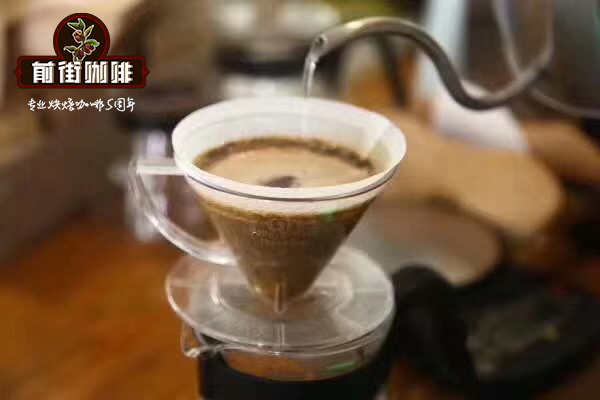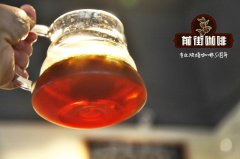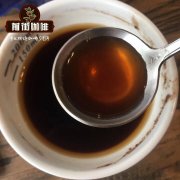Effect of temperature and Grinding degree on Coffee extraction what should be paid attention to in hand Coffee

Professional coffee knowledge exchange more coffee bean information please follow the coffee workshop (Wechat official account cafe_style)
Drinking coffee is really just a way of life. When it comes to coffee, always be careful to say that you don't understand, even if you drink it, you just drink it casually. Whether this cautious attitude is modest or not, it is really not that important to most people whether they know coffee or not.
If you drink a certain type of coffee, or all the body to a certain type of beans, a certain practice, feel good, can continue to drink is enough. However, this is really just a casual drink, if you expect to make a good cup of coffee at home, then you need to involve a lot of theoretical knowledge.
"temperature"
1. Extraction rate: the extraction rate of coffee is higher than that of temperature. Bitter and astringent coke is the later flavor, if the coffee is bitter, scorched, astringent, etc., the extraction water temperature can be reduced and adjusted. On the other hand, if you rush out and feel the smell of fresh water, there are still many flavors left in the coffee grounds, so you can consider raising the temperature. The specific extraction rate is related to water temperature, steaming time, extraction time, grinding thickness, even different grinding, different shape of particles after grinding, and so on. Water temperature is only one of the variables, which needs to be considered dialectically.
two。 Steaming in powder layer: under the premise of fresh beans, one of the noteworthy areas is the development of steamed powder layer. In terms of temperature dimension, the higher the temperature is, the faster the coffee powder expands and develops when water is injected into the powder. In the case of shallow baked beans, fine grinding and the powder layer is not easy to expand, it can be considered to increase the water temperature to assist the powder layer development, but to grasp the degree, based on the principle of extraction.
3. There are no fixed rules for this variable that can be adjusted, especially the hand flushing needs to be adjusted according to one's own preferences, generally, the water temperature is high and bitter, and low sour. It usually can be adjusted in the range of 80-92 degrees, depending on the baking degree of beans and which flavor characteristics of a certain bean you want to stimulate. It is recommended that the water temperature of beans with deeper baking degree be lower than 80-85. The water temperature of lighter baking is higher, 88-92 is usually moderate or unfamiliar with beans, it is recommended that 85-88 try this first, but also with grinding, steaming, to make specific adjustments.
4. Before beginners are proficient in hand brewing, or some beans that they are not familiar with, we usually recommend that the water temperature in the hand brewing pot is around 85-88, so that the brewed coffee can show the flavor of the coffee, and it will help to improve proficiency. Usually, it is not easy for beginners to master the size of the water column and the evenness of the circle. Do not be too persistent to stimulate some specific flavor of a certain type of beans, as long as you can not rush out the smell of scorched and fishy grass, it is enough to be able to flush out the flavor that coffee should have.
"Grinding thickness"
1. Extraction rate: the extraction rate of coffee is also affected by the size of grinding powder. The extraction rate of fine powder is higher than that of coarse powder. Hand flushing is a constant addition of water and continuous filtration, rather than siphon immersion. Therefore, the thickness of the powder is more important to the flow rate and the development of the powder layer. Here we only consider the thickness, regardless of the impact of higher-level, different brands of mills on the shape of grinding particles, etc. This is the place where money is spent. Bean grinders range from 100 yuan to tens of thousands of yuan each. Aiwo fragrance coffee this article "Coffee basis-the choice of hand-made bean grinder, how to choose the right bean grinder" has an introduction to the bean grinder. Friends in need can come and have a look at it. I don't introduce too much here, but I have introduced a lot in other articles before.
Ordinary enthusiasts have a little skill here. If it is an entry-level mill, then using a powder sieve can also achieve more than a thousand bean grinders. To put it simply, coffee powder needs to have appropriate fine powder, which can improve the hierarchical sense of the product, but when there are too many fine powder, it will become a source of miscellaneous flavor, so expensive grinding, such as more than 10,000, the grinding particles are very uniform, very few fine powder, and the taste is really much cleaner, but I feel that the layered feeling is almost almost. So I usually advise my friends to choose a bean grinder according to their capacity, and using a powder sieve is a good compromise.
two。 Powder layer development: usually fresh coffee beans will be better ground in the medium thickness powder layer (of course, this will change depending on the baking degree, the filtration equipment used in the extraction, etc.). The coarser the grinding is because the water passes through the powder layer very quickly, and the development of the powder layer becomes slower and finer because the water is not easy to block the water passage and develops slowly above the powder layer. Therefore, the coarse grinding water column and water injection speed can be slowed down to adjust the flow rate, while the relative fine grinding can dig a small hole in the powder layer to improve water penetration. Here is the principle of hand flushing and water control. It also needs dialectical consideration. In fact, extraction is a relationship that requires overall dialectical consideration. To find out these basic logical dialectical relations, it is not difficult to make a good cup of coffee.
"the ratio of coffee to water"
1. Concentration: increase the amount of powder, or reduce the amount of water injection to adjust. There is an article on the extraction rate of coffee: "Gold cup extraction suitable for hand siphon and other fine coffee extraction" specifically introduces the reasonable extraction rate. It is usually adjusted in the range of 1:10-22, and the common ratio is roughly between 1:12 and 18. Just do it according to your favorite taste.
two。 Content: the concentration of hand pulping will vary depending on the flow rate and the time for the water to stay in the coffee powder layer. As the amount of Chongduo cup powder is more and thicker, the longer the water stays in the powder layer, the higher the extraction efficiency. Compared with the more powder, the flow rate of the same boiling water column will cause a slower flow rate. Therefore, cooking a single cup needs to appropriately increase the amount of powder, small water column, multiple cups can appropriately reduce the amount of powder, increase the water column. This is why it is usually recommended: for example, 15 grams of powder per person, plus 10 grams per person. Specific needs to be considered according to different filter cup material size and other aspects, this is the basic principle, not a fixed water-powder ratio must be correct and reasonable, so it is not fixed, to dialectical point of view. If you understand the principle, you will know which way to make adjustments.
"baking degree"
1. Shallow baking: shallow baked beans usually swell and bubble after they encounter hot water. This is not that they are not fresh, but that the texture of shallow baked beans is relatively compact. And the beans that dare to bake lightly are high-grade high-quality beans. They are beans from high-altitude producing areas, and the texture will be much harder. Shallow baked beans contain less carbon dioxide gas after grinding, which is not easy to absorb water and expand, and it is easy to sink during cooking and cause sparse surface. This situation will affect the flow rate, so it is usually recommended that the shallow baked beans should have a high temperature of more than 90 ℃ and a smaller water column, so that it is easier to flush out the flavor. Once again, expansion bubbling does not have much effect on the flavor of coffee. In fact, it has a greater impact on the extraction process than on the flavor, and there is no need to worry too much about the size of the bubbling.
two。 Deep baking: deep-baked beans are relatively loose in texture, have good water absorption, the powder layer is easy to expand and bubble by water, and coffee powder is easy to float on the surface, but the more bitter and astringent coke and other miscellaneous flavors will be relatively heavy. Most of the high-quality beans are in medium light to medium deep, and most of them are roasted moderately. It won't even appear in the middle and deep. Because the heavy baking (long baking time and high temperature), the more obvious the bitter taste, and the more obvious the bitter taste, the less the flavor (except bitter), because the bitter taste will outweigh those special flavors, that is, the flavor characteristics of fine beans. Flower aroma, fruit acid, nuts, chocolate, cream … The taste, etc., will become heavier (bitter) with the baking, but less. Only some beans of poor quality will do deep and heavy baking, using bitterness to cover up the mixed taste of poor beans.
3. Therefore, the suggestions of baking degree and temperature are as follows:
Shallow baking: the temperature is about 9092 degrees. After boiling, pour it into a copper pot and brew it. Of course, it is best to have a thermometer.
Moderate baking: the temperature is about 85-90 degrees
Partial depth baking: the temperature is about 80 ~ 85 degrees.
This is only a suggested direction adjustment, not a fixed temperature range.
Important Notice :
前街咖啡 FrontStreet Coffee has moved to new addredd:
FrontStreet Coffee Address: 315,Donghua East Road,GuangZhou
Tel:020 38364473
- Prev

What is the significance of participating in the hand-brewing coffee competition? What are the 2018 hand coffee competitions?
Professional coffee knowledge exchange more coffee bean information please pay attention to the coffee workshop (Wechat official account cafe_style) hand coffee competition significance? Reflect the results of the game or test your ability, want to know your own strength to play is the best choice. Don't go to the game if you are already in the game, so that you can continue to wear the emperor's new clothes. The process of preparing for the game can improve your
- Next

What is the effect of the origin of coffee on coffee? some questions about coffee
Professional coffee knowledge exchange more coffee bean information please follow the coffee workshop (Wechat official account cafe_style) 1. The influence of altitude on water temperature A: different elevations have an impact on water temperature, so it is impossible to guess, and a thermometer can also play a great role. two。 Silver skin affects taste A: different varieties of raw coffee beans are treated in different ways, more or less
Related
- Beginners will see the "Coffee pull flower" guide!
- What is the difference between ice blog purified milk and ordinary milk coffee?
- Why is the Philippines the largest producer of crops in Liberia?
- For coffee extraction, should the fine powder be retained?
- How does extracted espresso fill pressed powder? How much strength does it take to press the powder?
- How to make jasmine cold extract coffee? Is the jasmine + latte good?
- Will this little toy really make the coffee taste better? How does Lily Drip affect coffee extraction?
- Will the action of slapping the filter cup also affect coffee extraction?
- What's the difference between powder-to-water ratio and powder-to-liquid ratio?
- What is the Ethiopian local species? What does it have to do with Heirloom native species?

